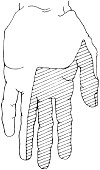- Epidemiology
- Female: Male:: 3:1
- Age peak: 40 to 60 years
- Dominant hand
- Often affected 1st & more severely
- More common in idiopathic cases
- Commonly becomes bilateral
- Rare in absence of pain
- Causes
- Idiopathic: ? Related to
- Congenital smallness of carpal tunnel
- Hand activity: Repetitive; Amount
- More common in dominant hand
- Occupational: Vibrating tool use
- Anatomic: Reduced space in carpal tunnel
- Tenosynovitis: Rheumatoid arthritis or suppurative
- Bone: Fracture; Osteophyte; Dislocation; Exostosis
- Mass: Ganglion; Gouty tophi; Hematoma
- Anomalous muscles
- Flexor digitorum sublimis
- Palmaris longus
- Median artery, Persistent
- Congenital smallness of carpal tunnel
- Neoplasms: Ganglia; Hemangioma; Lipoma;
Neurofibroma; Schwannoma
- Susceptibility of nerve to pressure
- Systemic disorders
- Pregnancy: Often resolves after delivery
- Endocrine
- Multiple myeloma
- Amyloidosis
- Obesity
- Osteochondritis dissecans
- Spasticity
- Edema
- Immune disorders: Rheumatoid arthritis; Sarcoid
- Infection: Histoplasmosis; Lyme; Septic arthritis; Tubercuolsis
- Hereditary
- CTS Risk factors
- Biglycan (BGN)

- Aggrecan (ACAN)

- COL5A1

- IL6R

- NGF-β: Heterozygotes
5
- Carpal tunnel syndrome
 1
1
- Anatomy
- Wrist X-rays: Narrow carpal tunnel
- Thick transverse carpal ligament
- Epidemiology
- 1 family
- All female
- Lethal in males
- Genetics
- Clinical
- Onset
- Age: < 2nd decade
- Pain in lateral fingers
- Bilateral
- Recessive: Childhood onset
- CTS1
 : TTR, Dominant : TTR, Dominant
- CTS2: COMP, Dominant
- Mucopolysaccharidosis: Scheie
- Mucolipidosis
- HNPP
- SH3TC2 heterozygote

- NGFB carriers
- Klippel-Trenaunay-Weber
- Childhood
- Acute
- Wrist fractures (Colles), dislocations (lunate bone, hyperextension), hematomas
- Pyogenic infections: tenosynovitis
- Rhematoid arthritis: Acute exacerbation
- Excessive unaccustomed manual work
- Clinical features
- Clinical
- Pain
- Episodic
- Temporal: Worse at night initially; Later during day also
- Location: Arm, forearm, wrist, hand & fingers
- Repetitive or sustained activity: Exacerbates pain
- Flick sign: Nocturnal awakening with pain relieved by vigorous hand shaking
- Paresthesias & Sensory loss
- Palmar thumb, 2nd, 3rd & medial 4th fingers
- Finger tips
- Nocturnal: Common
- Normal: Thenar eminence
- Weakness: After sensory loss
- Abductor pollicis brevis (APB): Most common
- Opponens pollicis
- Provocative tests
- Phalen maneuver
- Wrist held passively flexed
- Symptoms in 30 to 120 sec
- Most common: Paresthesias in index or middle finger
- Tinel sign
- Tapping over median nerve at wrist
- Produces paresthesias
- May be false positive
- Treatment
- Splinting
- Set to reduce pressure in carpal tunnel
- Wrist angle: Neutral (Close to 0°)
- Corticosteroid injections
- Surgical decompression: Complete section of transverse carpal ligament
- Primary treatment in acute carpal tunnel syndrome
- Avoid in pregnancy
- Laboratory
- Electrodiagnostic
- Slow sensory conduction across transverse carpal ligament: Most sensitive
- Later changes: Long motor latency; Low CMAP; Denervation in APB
- Ultrasound: Nerve properties
- Hypoechogenicity
- Vascularity: Increased
- Mobility: Decreased
- Cross-sectional area: Increased
- Flexor retinaculum: Increased bowing
- Systemic work-up: Thyroid; Blood sugar; Sed rate; CBC
- External link: Ortho-u
|

From: C Zaidman
Carpal tunnel syndrome: Ultrasound images of Median Nerves
Cross-sectional area: Increased
Echogenicity: Reduced
|
|



